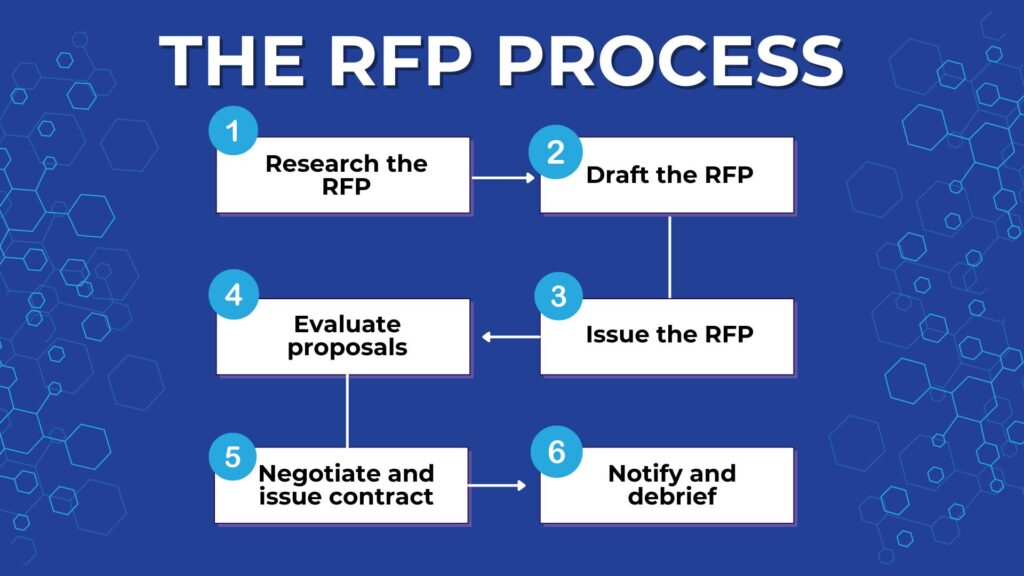The RFP Bidding Process Explained: A Guide to Success
Have you struggled to secure a contract or find the right supplier for a project? The Request for Proposal (RFP) process can be convoluted and time-consuming, but it equips organizations to locate, vet, and hire appropriate suppliers.
At Graphite, we make it easier for buyers and sellers to connect and conduct business securely. If you’re looking to improve your supplier selection and minimize obstacles in the RFP process, this guide to the RFP bidding process will provide you with the practical knowledge and insights needed to succeed.
What is an RFP bid?
An RFP bid is a formal request issued by a company to potential suppliers or service providers, asking them to submit a proposal for a specific project or service. The RFP defines the project, outlines the bidding process, and specifies the contract terms. Companies then compare different proposals and choose the best fit for their needs.
Government agencies and private organizations alike commonly use the RFP bidding process. It helps ensure that the buyer finds the best vendor for their project, as opposed to a less formal process that may not yield the best results.
RFP vs. RFQ vs. RFI: What’s the difference?
When it comes to procurement, you’ll likely encounter three common terms: RFP, RFQ, and RFI. Navigating the procurement process more efficiently begins with understanding their differences.
RFP (Request for Proposal)
An RFP is a formal request issued by a company asking potential suppliers or service providers to submit a proposal for a specific project or service. It includes detailed information about the project, its goals, and the bidding process. Companies use RFPs to evaluate different proposals and select the best one based on various criteria, such as price, experience, and approach.
RFQ (Request for Quote)
An RFQ is a request for a price quote for specific products or services. Unlike an RFP, which focuses on the overall solution and approach, an RFQ is more straightforward and price-oriented. Companies use RFQs when they have a clear understanding of their needs and are primarily interested in comparing prices from different vendors.
RFI (Request for Information)
An RFI is a preliminary request issued to gather general information about potential suppliers and the products or services they offer. It is used when a company is exploring options and needs more information before moving forward with an RFP or RFQ. RFIs help companies understand the capabilities of different vendors and narrow down their choices.
Who is involved in an RFP bid?

The RFP bidding process involves several key players, each with specific roles and responsibilities. Understanding who they are and what they do can help clarify the chain of responsibility throughout the RFP bidding process.
The Issuing Company
The issuing company is the organization that creates and releases the RFP. It has a project or service need and is looking for the best supplier or service provider to fulfill it. Within the issuing company, several roles may be involved:
- Project Manager: Oversees the entire project and ensures the RFP aligns with the project’s goals and requirements.
- Procurement Team: Manages the RFP process, from drafting the document to evaluating proposals and selecting the winning bid.
- Subject Matter Experts (SMEs): Provide detailed information and technical specifications for the RFP based on their expertise.
Potential Bidders
Potential bidders are the suppliers, vendors, or service providers who respond to the RFP. Their role is to prepare and submit a proposal that outlines how they will meet the project’s requirements. Key participants from the bidding companies include:
- Sales Team: Prepares the proposal, which highlights the company’s capabilities and how they meet the RFP requirements.
- Technical Experts: Provide detailed technical information and solutions to address the specific needs outlined in the RFP.
- Finance Team: Ensures the pricing and budget aspects of the proposal are competitive and feasible.
Evaluation Committee
The evaluation committee within the issuing company is responsible for reviewing and scoring the submitted proposals. Their role is to assess each bid against the criteria outlined in the RFP. The committee typically includes:
- Procurement Officers: Ensure the evaluation process is fair and unbiased.
- Technical Advisors: Review the technical aspects of the proposals to ensure they meet the project’s requirements.
- Financial Analysts: Evaluate the cost proposals to determine the best value for the company.
Decision Makers
The final decision-makers are typically senior executives or management within the issuing company who make the ultimate choice on which bid to accept. They consider the evaluation committee’s recommendations and make a decision based on strategic alignment, budget, and overall value.
When should you issue an RFP?
You should issue an RFP when you have a well-defined project with clear goals, requirements, and specifications. This ensures that potential bidders understand exactly what you need and can provide accurate and relevant proposals. Typically, you should issue the RFP several weeks or even months before you need to make a decision, depending on the complexity and urgency of the project. This helps to ensure that potential bidders have sufficient time to generate their proposals and that the issuing company has adequate time to review and make its decision.
How long does the RFP bidding process take?
The RFP bidding process can vary in length, but it generally takes anywhere from several weeks to a few months. Below is a brief overview of the typical timeline.
- Preparation (1-2 weeks): During this phase, the issuing company drafts the RFP document, which defines the project requirements, goals, and evaluation criteria.
- Distribution (1 week): The RFP is then sent to potential bidders and posted publicly if necessary.
- Response Time (4-6 weeks): Bidders are given sufficient time to prepare and submit their proposals. The response period can vary depending on the complexity of the project.
- Evaluation (2-4 weeks): The issuing company reviews and scores the received proposals. This phase includes clarifying any questions with bidders and conducting initial evaluations.
- Selection (1-2 weeks): The company finalizes the decision, negotiates terms, and selects the winning bid.
- Awarding the Contract (1 week): Finally, the contract is issued to the chosen vendor, and the project officially begins.
The RFP bidding process typically takes around 10 to 16 weeks. Graphite Connect can help reduce that time by standardizing RPF submissions and making it easier for vendors to compile documentation and assign specific action items to the right team member. Graphite Connect minimizes friction in the RFP procurement process by providing organizations with a centralized RFP repository with secure data sharing – expediting the information-sharing process.
Similarly, Graphite Connect makes it easy for suppliers to streamline their responses, share their profiles with multiple prospective buyers, and quickly provide the necessary documentation.
The RFP bid process

The RFP bid process makes it easier for companies to compare multiple bids and select the best vendor to meet their needs. Here’s an overview of the different stages involved.
Step 1: Research the RFP
Researching the RFP is an extensive step that involves several key activities:
- Opportunity Identification: Identify potential projects or services that require an RFP. This involves market research and understanding the needs of the company.
- Spend Analysis: Analyze past expenditures and the market value of similar projects to determine the budget.
- Requirements and Scope: Clearly define what the project entails, including the specific needs and objectives.
- Budget: Establish a budget for the project to ensure that it stays financially feasible.
- Timeline: Create a timeline for the project, including key milestones and deadlines.
- Submission Requirements: Specify what bidders need to include in their proposals, such as technical details, pricing, and references.
- Evaluation Criteria: Determine the criteria that will be used to evaluate the proposals, such as cost, experience, and technical capability.
- RFP Questions: Prepare a list of questions that bidders may need to answer to provide clarity on their proposals.
Step 2: Draft the RFP
Drafting the RFP involves putting together all the information gathered in the research phase into a formal document. This document should clearly outline the project requirements, scope, budget, timeline, submission requirements, and evaluation criteria. It should also include instructions for how bidders can ask questions and seek clarifications during the bidding process.
Step 3: Issue the RFP
Once the RFP is drafted, it is issued to potential bidders. This can be done by sending it directly to known vendors, posting it on relevant platforms, or both. After issuing the RFP, the company waits for responses from the bidders. It’s important to allow sufficient time for vendors to prepare thorough and competitive proposals.
Step 4: Evaluate proposals
Evaluating proposals involves reviewing and scoring each submission based on the predefined evaluation criteria. This step may include:
- Assessing the technical aspects of each proposal to ensure they meet the project requirements.
- Comparing the cost proposals to ensure they are within budget and offer good value.
- Reviewing the bidders’ past performance and references to gauge their reliability and capability.
Step 5: Negotiate and issue the contract
After evaluating the proposals, the company selects the most suitable bidder and enters into contract negotiations. This step involves discussing the terms and conditions, finalizing the scope of work, and agreeing on the price. Once the negotiations are complete, the contract is issued to the chosen vendor.
Step 6: Notify and debrief
The final step involves notifying all bidders of the outcome and providing a debrief to those who request it. This is an opportunity to give feedback to unsuccessful bidders and learn from the process to improve future RFPs. Conducting a thorough debrief can help enhance vendor relationships and improve the quality of future proposals.
Expedite the RFP bidding process with Graphite Connect
While thorough and detailed, the RFP bidding process is essential for selecting the best vendor to meet your project or service needs. With Graphite Connect, you can streamline each phase of the RFP process, from initial research to final contract issuance, making your procurement efforts more effective and less time-consuming.Ready to improve your RFP bidding process? Discover how we can help. Get started with Graphite Connect today!
